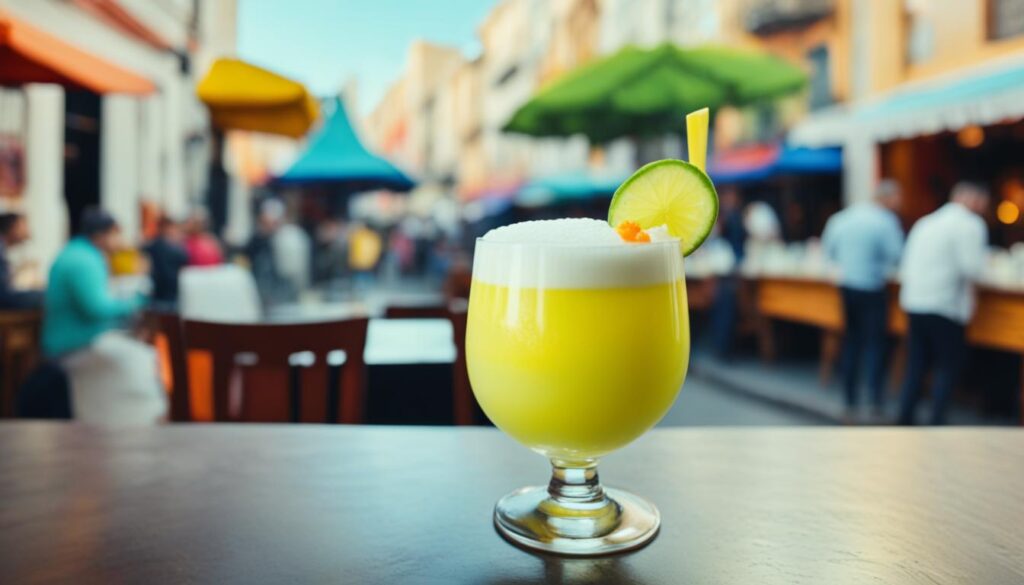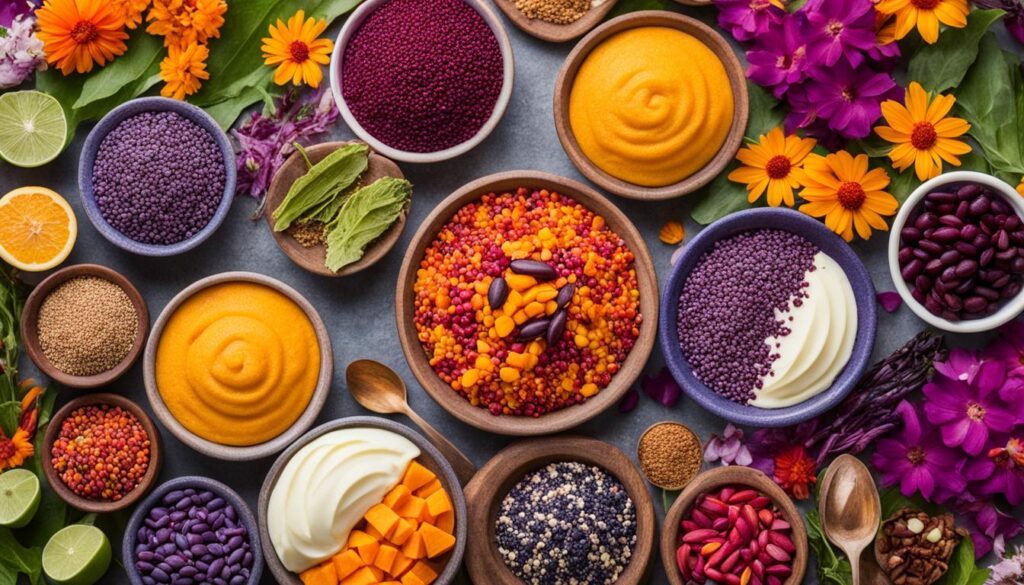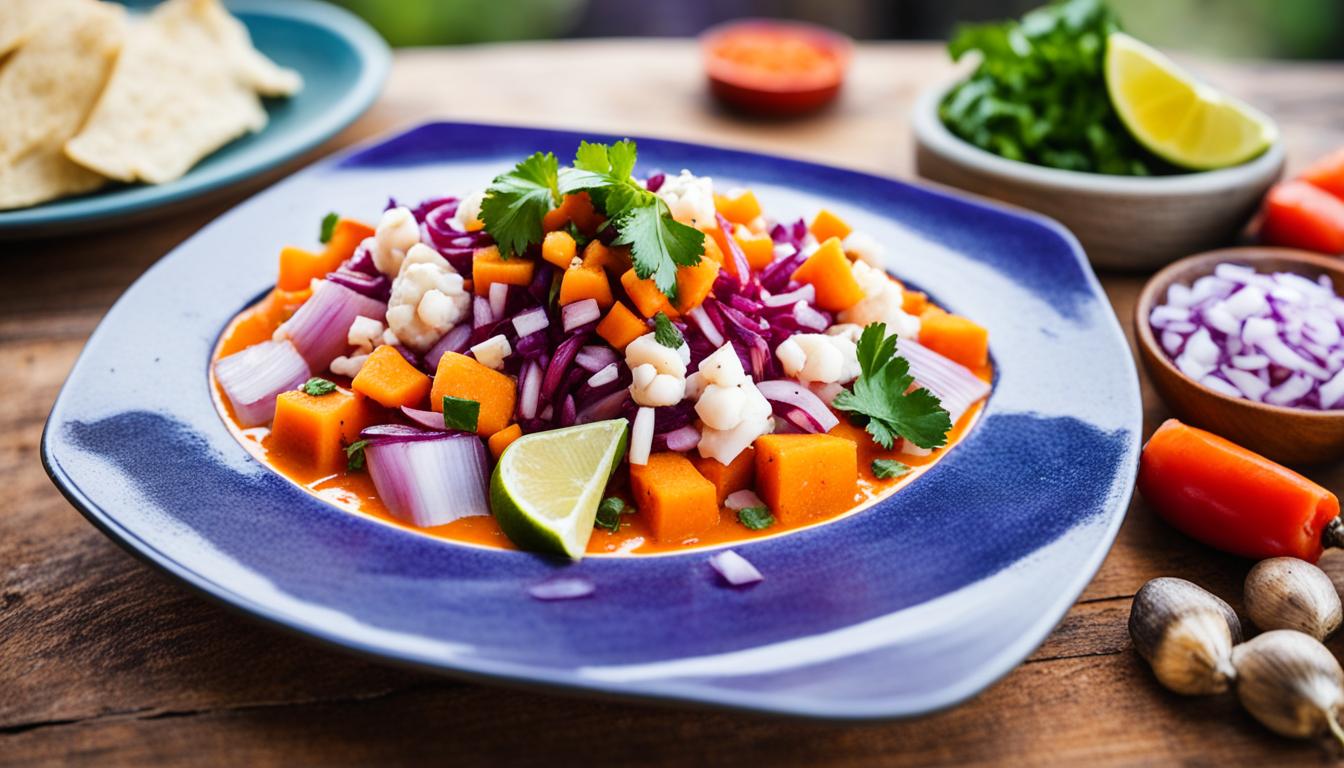Peruvian Cuisine: Flavors That Excite Your Palate
Have you ever experienced a burst of flavors that transport you to a world of culinary delight? Imagine savoring traditional Peruvian dishes with their rich and authentic flavors, each bite surprising your taste buds in the most wonderful way. From iconic ceviche to savory lomo saltado, Peruvian cuisine offers a gastronomic adventure that will leave you craving for more.
Peruvian cuisine is not just about food; it’s a reflection of a vibrant food culture that draws from a diverse range of influences. So, what makes Peruvian cuisine so unique? Can you guess the secret behind the unparalleled flavors that captivate food enthusiasts worldwide? Prepare to unravel the enigma of Peruvian cuisine and discover the enticing flavors that await you.
Key Takeaways:
- Peruvian cuisine offers a wide range of traditional dishes with rich and authentic flavors.
- It is a reflection of a vibrant food culture that blends indigenous ingredients and international influences.
- Peruvian cuisine includes iconic dishes like ceviche and lomo saltado.
- The fusion of cultural influences has shaped the diverse and exciting Peruvian food culture.
- Peruvian gastronomy goes beyond traditional dishes, with street food and fusion cuisine adding to the culinary experience.
Exploring Peruvian Cuisine: Ceviche and More
Peruvian cuisine is a treasure trove of vibrant flavors and traditional dishes that have captivated food enthusiasts worldwide. One of its most iconic and beloved dishes is ceviche.
Ceviche is a refreshing and tangy dish made with fresh raw fish, expertly marinated in citrus juices such as lime or lemon. The acid in the citrus juice “cooks” the fish, resulting in a tender texture and a burst of fresh flavors. It is often combined with onions, chili peppers, and cilantro, adding additional layers of zest and complexity to the dish. Ceviche showcases the incredible balance of Peruvian flavors, combining the sea’s bounty with the freshness of local produce.
Another must-try dish in Peruvian cuisine is lomo saltado. This mouthwatering delight is a fusion of Peruvian and Chinese flavors, which were influenced by the arrival of Chinese immigrants in Peru. Lomo saltado features stir-fried beef, onions, tomatoes, and soy sauce, creating a harmonious blend of savory, tangy, and slightly sweet flavors. The dish is typically served with rice and crispy french fries, adding a delightful crunch to each bite.
These dishes epitomize the essence of Peruvian cuisine, showcasing the rich tapestry of flavors and diverse culinary influences woven throughout the country’s history.
| Dish | Description |
|---|---|
| Ceviche | A refreshing dish made with raw fish marinated in citrus juices, onions, chili peppers, and cilantro. |
| Lomo Saltado | A fusion dish combining Peruvian and Chinese flavors, featuring stir-fried beef, onions, tomatoes, and soy sauce. |
Peruvian Culinary Influences: From Inca to Afro-Peruvian

Peruvian cuisine is a captivating blend of cultural influences that reflect the country’s rich history. With roots in the Inca civilization, Spanish colonization, Asian migration, and African heritage, Peruvian food embraces a diverse range of flavors and ingredients.
The Inca civilization, renowned for their agricultural practices, introduced staple foods that form the foundation of Peruvian cuisine. Quinoa, corn, and potatoes are among the indigenous crops that continue to play a vital role in Peruvian dishes.
“Peruvian cuisine is a reflection of a vibrant tapestry of cultures and their unique contributions to the culinary landscape.”
Spanish colonization introduced new ingredients and cooking techniques that greatly influenced Peruvian cuisine. Garlic, onions, and various meats were brought to the region, enriching the flavors and expanding the culinary possibilities. The Spanish legacy can still be seen today in traditional dishes like anticuchos and ají de gallina.
Asian migration to Peru, especially from China and Japan, further added to the country’s culinary tapestry. Chinese immigrants, known as the “chifa,” brought stir-frying techniques and soy sauce, resulting in dishes like lomo saltado. Japanese immigrants contributed to the art of sushi-making and introduced flavors like ginger and soy, elevating the Peruvian cuisine experience.
Afro-Peruvian influences are deeply rooted in the country’s history, as African slaves made significant contributions to Peruvian cuisine. Their culinary traditions brought ingredients such as sweet potatoes and yams, as well as techniques like slow-cooking stews. Afro-Peruvian flavors can be savored in dishes like seco de carne and tacu tacu.
Peruvian Culinary Influences
| Cultural Influence | Contributions |
|---|---|
| Inca Civilization | Staple foods: quinoa, corn, potatoes |
| Spanish Legacy | New ingredients: garlic, onions, meats |
| Asian Connection | Flavors and techniques from China and Japan |
| Afro-Peruvian Influences | Ingredients and cooking techniques |
This fusion of cultural influences has shaped Peruvian cuisine into an exciting culinary adventure, showcasing a harmonious blend of flavors, ingredients, and cooking techniques.
By embracing its diverse heritage, Peruvian cuisine offers a unique gastronomic experience that continues to captivate food enthusiasts around the world.
Exploring Peruvian Gastronomy: From Street Food to Fusion Cuisine

Peruvian cuisine is renowned for its diverse culinary offerings, extending beyond traditional dishes to include a range of gastronomic experiences. From iconic cocktails to vibrant street food and innovative fusion cuisine, Peruvian gastronomy is a true delight for food enthusiasts.
Iconic Cocktails: The Pisco Sour
When it comes to Peruvian cocktails, the Pisco Sour takes center stage. This classic drink is made with Pisco, a grape brandy, mixed with lime juice, sugar, and egg white, resulting in a refreshing and tangy libation. The Pisco Sour perfectly encapsulates the flavors of Peruvian cuisine and is a must-try for any visitor.
Vibrant Beverages: Chicha Morada
Another beverage that showcases the vibrant flavors of Peru is Chicha Morada. This non-alcoholic drink is made from purple corn and infused with fruits, spices, and lime juice. Chicha Morada offers a unique blend of sweetness and tartness, making it an ideal companion to Peruvian cuisine.
Tantalizing Street Food
Peruvian street food is a culinary experience like no other. The streets of Peru are lined with vendors selling a variety of mouthwatering treats that showcase the country’s culinary heritage. From savory empanadas filled with seasoned meat and vegetables to steamed tamales bursting with flavor, Peruvian street food offers a taste of authenticity on every corner.
Innovative Fusion Cuisine
Peruvian cuisine is known for its creative fusion of flavors and techniques. With an abundance of fresh and diverse ingredients, Peruvian chefs excel at blending traditional Peruvian ingredients with international influences. The result is a dynamic and innovative cuisine that surprises and delights the palate.
For a complete and immersive experience of Peruvian gastronomy, cooking classes and visits to traditional markets are highly recommended. These activities provide an opportunity to learn about the ingredients, techniques, and cultural significance behind each dish.
Sustainability and Desserts in Peruvian Cuisine

Sustainability plays a crucial role in the vibrant tapestry of Peruvian cuisine. With a strong emphasis on locally sourced ingredients and eco-friendly cooking methods, Peruvian chefs and restaurants are at the forefront of promoting sustainable practices.
The Importance of Locally Sourced Ingredients
Peruvian cuisine values the use of locally sourced ingredients, which not only supports local farmers and producers but also reduces carbon footprint by minimizing transportation distances. By prioritizing locally grown fruits and vegetables, Peruvian chefs ensure that their dishes are not only fresh and flavorful but also environmentally friendly.
Eco-Friendly Cooking Methods
Peruvian chefs are also committed to employing eco-friendly cooking methods that reduce energy consumption and waste. Utilizing energy-efficient equipment and implementing sustainable practices in their kitchens, they aim to minimize their ecological impact while still delivering scrumptious dishes.
Peruvian Desserts: A Sweet Finale
No exploration of Peruvian cuisine is complete without indulging in the delightful world of Peruvian desserts. These sweet treats showcase the ingenuity and creativity of Peruvian pastry chefs, who skillfully blend traditional flavors with modern techniques.
One popular Peruvian dessert is the Alfajores, a delectable cookie sandwich filled with creamy dulce de leche. The combination of tender, melt-in-your-mouth cookies and rich caramel filling makes it an irresistible treat.
Another must-try dessert is Picarones, which are deep-fried pumpkin and sweet potato doughnuts. Served with a drizzle of sweet molasses or syrup, Picarones are the perfect blend of crispy exterior and soft, fluffy interior.
Through their inventive use of local ingredients and commitment to sustainability, Peruvian pastry chefs demonstrate that delightful desserts can be enjoyed with a clear conscience.
So, for those with a passion for the culinary arts and a love for sustainability, exploring the world of Peruvian cuisine is a flavorful journey that combines tantalizing dishes with a commitment to preserving our planet.
Sustainable Practices in Peruvian Cuisine
| Sustainable Practices | Benefits |
|---|---|
| Locally sourced ingredients | – Supports local farmers and producers – Reduces carbon footprint |
| Eco-friendly cooking methods | – Minimizes energy consumption – Reduces waste |
Conclusion
Peruvian cuisine is a vibrant tapestry of history, culture, and flavors that has gained recognition worldwide. With its diverse influences from ancient Andean traditions to Spanish colonization, Asian connections, and Afro-Peruvian influences, Peruvian food offers a tantalizing array of dishes that excite the palate.
Whether you’re savoring the refreshing tang of Peruvian ceviche, indulging in the innovative flavors of fusion cuisine, or enjoying the sweet finale of traditional Peruvian desserts, each bite takes you on a culinary journey through Peruvian food culture.
Peruvian cuisine has captivated food enthusiasts globally with its authentic flavors and unique combinations. It embodies the culinary history and traditions of Peru, showcasing the richness and creativity of Peruvian chefs and their commitment to sustainable practices.
So, immerse yourself in the world of Peruvian cuisine, discover the flavors that have enchanted generations, and embark on a gastronomic adventure that will leave you craving the authentic tastes of Peruvian cuisine.







